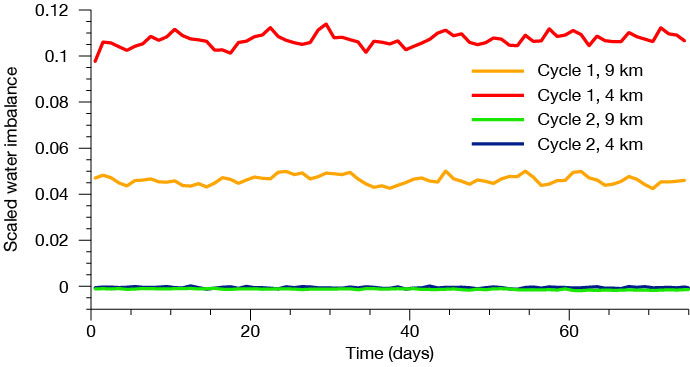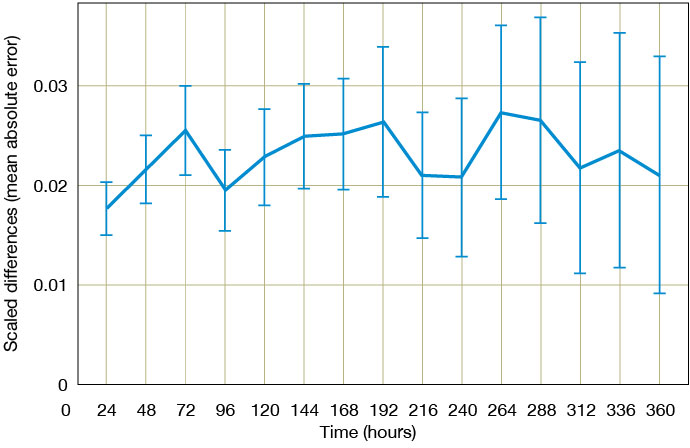This year, major progress has been made to significantly improve the conservation of water and energy in ECMWF’s Integrated Forecasting System (IFS). The work was inspired by the first Next Generation Earth Modelling Systems (NextGEMS) project hackathon in October 2021, which quantified water and energy budget imbalances and showed they become considerably worse at the higher resolutions being tested for future applications. NextGEMS is an EU Horizon 2020 project involving participants from 12 of our ECMWF Member States. It aims to analyse up to 30 years of coupled simulations at 2 to 5 km resolution (in the atmosphere and ocean) with both the IFS and the German Icosahedral Nonhydrostatic Weather and Climate Model (ICON). Further investigation at ECMWF established that most of the energy imbalance in the IFS was due to water not being conserved. The causes were identified and solutions found.
Scope of the problem
In the 9 km configuration of the IFS used for ECMWF’s operational high-resolution ten-day forecasts, the atmospheric energy imbalance is found to be 2.0 Wm–2, and this increases to 6.4 Wm–2 at experimental resolutions of 4 to 5 km with no parametrization of deep convection. Analysis shows that most of the energy imbalance in the IFS is related to water non-conservation, and that this issue gets worse when spatial resolution is increased and when the parametrization of deep convection is switched off. The first figure shows that the initial round (Cycle 1) of NextGEMS simulations with the IFS have an artificial source of water in the atmosphere. This is responsible for 4.6% of total precipitation in the simulation with deep convection parametrization at 9 km, and for 10.7% without deep convection parametrization at 4 km.
The water non-conservation of the IFS had been known for a long time, given that interpolation at the departure point locations in the semi-Lagrangian advection scheme used in the IFS is non-conserving. However, while this issue was acknowledged to be detrimental for the accuracy of climate integrations, so far it was thought that it was small enough to not significantly affect the quality of numerical weather forecasts, which span timescales ranging from a few hours to seasons ahead. Further analysis after the hackathon by the modelling teams at ECMWF has shown that about 50% of this artificial atmospheric water source is created as water vapour. The additional water vapour not only affects the radiation energy budget of the atmosphere, but it can also cause energy non-conservation when heat is released through condensation. The other 50% of water is created as cloud liquid, cloud ice, rain or snow. The artificial source of water for cloud and precipitation is related to the higher-order interpolation in the semi-Lagrangian advection scheme introduced in IFS Cycle 47r3. This can result in spurious maxima and minima, including negative values, which are then clipped to remain physical.
It turns out that the spurious minima are in excess of the spurious maxima and by clipping them we effectively increase the condensate mass.

Finding a solution
To address the problem of water non-conservation in the IFS, global tracer mass fixers were activated for all moist species, including water vapour. Activating tracer mass fixers increases the computational cost of running a simulation. However, an accurate yet cost-effective setup was found that uses a finite differences approach rather than a finite elements approach to calculate the vertical integrals for the tracer mass fixers, and further code optimisations were introduced. Note that tracer mass fixers assure global mass conservation, so locally tracer non-conservation is still possible but is expected to have been reduced (the fixer can estimate locally where the mass conservation errors are larger and hence it inserts larger corrections in such regions always obeying a monotonicity constraint). The first figure shows that, with global mass fixers, global water non-conservation is essentially eliminated (about 0.1%) in our new NextGEMS simulations (labelled Cycle 2), while the global energy budget imbalance has reduced to less than 1 Wm–2 (not shown).
Better forecasts
Importantly, global water conservation turns out to be beneficial not only for long integrations, but also for the quality of ECMWF’s medium-range weather forecasts. Preliminary results suggest that the model changes performed to fix the water and energy imbalances reduce the overestimate of mean precipitation at different timescales and improve the skill scores for the upcoming resolution upgrade of medium-range ensemble weather forecasts. The second figure shows that the mean absolute error of precipitation against rain gauge measurements is about 2–3% smaller in 9 km forecasts that ensure global water conservation compared to the default 9 km forecasts. The tracer mass fixers are expected to be activated, with improved water and energy conservation, in Cycle 48r1.


